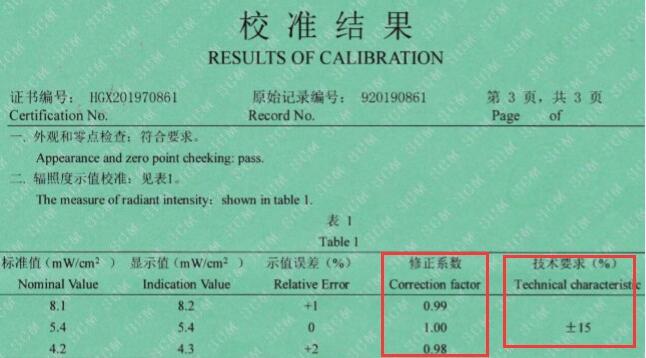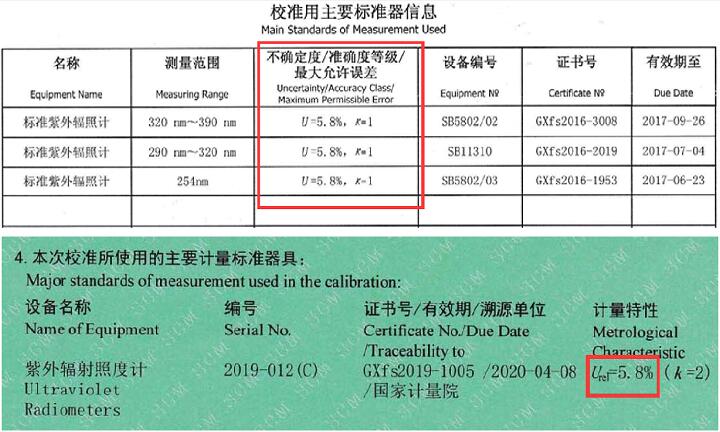UV Integrator Calibration
I. Linshang UV energy meter calibration instruction
The four UV integrators independently developed and produced by Linshang Technology are mainly divided according to the spectral response curve. The spectral response range of some models is 315-400nm, which is mainly suitable for detecting high-pressure mercury lamps, halogen lamps, etc .; the spectral response range of other models is 340-420nm, which is mainly suitable for detecting UV LED light sources. The specific models are shown in the following table:
| Model | Spectral response | Applicable light source | Calibration basis |
| LS120 | 315-400nm | high pressure mercury lamp;halogen lamp | JJG 879-2015 VerificationRegulation of Ultraviolet Radiometers |
| LS130 | |||
| LS125 host+UVA-X0 probe | |||
| LS128 | 340-420nm | UV LED light source | No international or Chinese standard |
| LS131 | |||
| LS125 host + UVALED-X0 | |||
| LS125 host + UVALED-X1 | |||
| LS126A |
1. UV integrator with spectral response range of 315-400nm
The calibration conditions for UV integrators with a spectral response range of 315-400nm are generally high pressure mercury lamps with a peak wavelength of 365nm. The technical basis for calibration is "JJG 879-2015 Verification Regulation of Ultraviolet Radiometers ". The LS125 uv integrator host is equipped with a UVA-X0 probe. The LS120 and LS130 UV integrators can pass the inspection in any Chinese national legal metrological verification agencies. The calibration technical requirements for UV irradiance and energy values are ± 15%.
2. The uv integrator with a spectral response range of 340-420nm
An UV integrator with a spectral response range of 340-420nm is suitable for detection. UV LED are high-efficiency and energy-saving light sources that has emerged in recent years. At present, there is no uniform measurement standard or any national standard worldwide.
Therefore, the UV integrator data designed for LED light sources is basically adjusted according to the manufacturer's standards. There will be differences in data between different brands of energy meters. It cannot be sent to any metrology institute for measurement verification. (At present, there are individual metrology institutes that use traditional high-pressure mercury lamps or other unsuitable standards to measure all UV integrators indiscriminately, but the actual calibration results do not make much sense)
II. Why the calibration result is different in different institutes?
Some customers report that the UV integrator delivered by our company to the metrology institute cannot pass the calibration. But when the customer sent the instrument to another metrology institute, the instrument can pass the inspection, which is mainly due to the existence of standard appliances used between different metrology institutes. The difference can be seen from the figure below. The standard used by the metrology institute has an uncertainty of 5.8%. The national calibration technical requirement for ultraviolet is ± 15% (for high-pressure mercury lamps). Therefore, when sending instrument to different metrology institutes for inspection, The following situations may occur:
Example: Suppose the standard value of UV power is 100
The standard of A Metrology Institute is + 5.8% error, that is, the standard value of A Metrology Institute is 105.8
The standard device of B Metrology Institute is -5.8% error, that is, the standard value of A Metrology Institute is 94.2
The UV energy meter conforms to the national standard ± 15%, then the measured values 115 and 85 are qualified.
Assuming that the measured value of the energy meter in the A and B metrology institutes is 115, then:
The deviation between A measurement institute and standard value (115-105.8) /105.8= 8.7%, then in A measurement institute, it can pass the measurement
The deviation between the B measurement institute and the standard value (115-94,2) /94.2=22.1%, then in the B measurement institute, the measurement cannot be passed.
III.UV energy meter calibration suggestion
The difference between calibrators between different metrology institutes is unavoidable. If you believe in us, please contact us for reference before submitting for inspection, or give priority to legal metrological verification agencies at the provincial level or above, including China Institute of Metrology Science, China Institute of Testing Technology, 7 National Metrology and Testing Centers and 30 Provincial Metrology Research Institutes.


The UV LED light source has no uniform standard in the world. The UV integrator data designed for LED light sources is basically adjusted according to the manufacturer's standards. Linshang Technology has several UV LED energy meters. There will be differences in data between different brands of energy meters. It cannot be sent to any metrology institute for measurement verification. (At present, there are individual metrology institutes that use traditional high-pressure mercury lamps or other unsuitable standards to measure all UV integrators indiscriminately, but the actual calibration results do not make much sense)